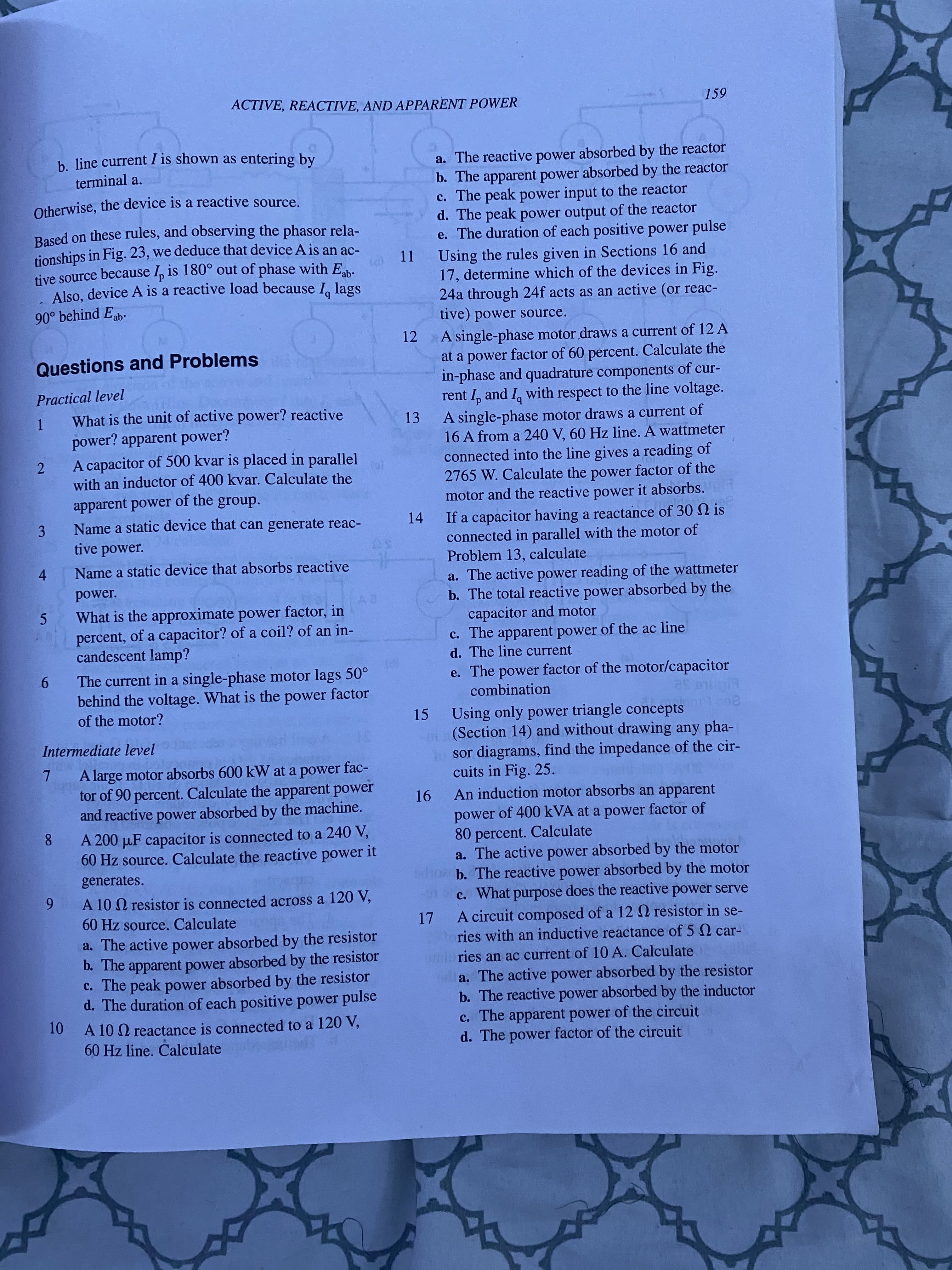An induction motor absorbs an apparent power of 400 kVA at a power factor of 80 percent. Calculate a. The active power absorbed by the motor
An induction motor absorbs an apparent power of 400 kVA at a power factor of 80 percent. Calculate a. The active power absorbed by the motor
Computer Networking: A Top-Down Approach (7th Edition)
7th Edition
ISBN:9780133594140
Author:James Kurose, Keith Ross
Publisher:James Kurose, Keith Ross
Chapter1: Computer Networks And The Internet
Section: Chapter Questions
Problem R1RQ: What is the difference between a host and an end system? List several different types of end...
Related questions
Question
16 letter a

Transcribed Image Text:00
ACTIVE, REACTIVE, AND APPARENT POWER
159
b line current I is shown as entering by
a. The reactive power absorbed by the reactor
b. The apparent power absorbed by the reactor
c. The peak power input to the reactor
d. The peak power output of the reactor
e. The duration of each positive power pulse
terminal a.
Otherwise, the device is a reactive source.
Based on these rules, and observing the phasor rela-
tionships in Fig. 23, we deduce that device A is an ac-
tive source because I, is 180° out of phase with E.
Also, device A is a reactive load because I lags
11 Using the rules given in Sections 16 and
17, determine which of the devices in Fig.
24a through 24f acts as an active (or reac-
tive) power source.
90° behind Eab.
12 A single-phase motor draws a current of 12 A
at a power factor of 60 percent. Calculate the
in-phase and quadrature components of cur-
rent I, and I, with respect to the line voltage.
Questions and Problems
Practical level
What is the unit of active power? reactive
1.
power? apparent power?
A single-phase motor draws a current of
16 A from a 240 V, 60 Hz line. A wattmeter
connected into the line gives a reading of
2765 W. Calculate the power factor of the
motor and the reactive power it absorbs.ER
13
A capacitor of 500 kvar is placed in parallel
2.
with an inductor of 400 kvar. Calculate the
apparent power of the group.
Name a static device that can generate reac-
3.
tive power.
If a capacitor having a reactance of 30 N is
connected in parallel with the motor of
Problem 13, calculate
a. The active power reading of the wattmeter
b. The total reactive power absorbed by the
capacitor and motor
c. The apparent power of the ac line
d. The line current
14
Name a static device that absorbs reactive
4.
power.
What is the approximate power factor, in
percent, of a capacitor? of a coil? of an in-
candescent lamp?
The current in a single-phase motor lags 50°
9.
behind the voltage. What is the power factor
e. The power factor of the motor/capacitor
combination
of the motor?
Using only power triangle concepts
(Section 14) and without drawing any pha-
1 sor diagrams, find the impedance of the cir-
cuits in Fig. 25.
An induction motor absorbs an apparent
15
Intermediate level
A large motor absorbs 600 kW at a power fac-
tor of 90 percent. Calculate the apparent power
and reactive power absorbed by the machine.
power of 400 kVA at a power factor of
80 percent. Calculate
a. The active power absorbed by the motor
b. The reactive power absorbed by the motor
c. What purpose does the reactive power serve
A 200 µF capacitor is connected to a 240 V,
60 Hz source. Calculate the reactive power it
generates.
A 10 N resistor is connected across a 120 V,
60 Hz source. Calculate
a. The active absorbed by the resistor
b. The apparent power absorbed by the resistor
c. The peak power absorbed by the resistor
d. The duration of each positive power pulse
17 A circuit composed of a 12 2 resistor in se-
ries with an inductive reactance of 5 Q car-
power
niries an ac current of 10 A. Calculate
a. The active power absorbed by the resistor
b. The reactive power absorbed by the inductor
c. The apparent power of the circuit
d. The power factor of the circuit
10 A 10 Q reactance is connected to a 120 V,
60 Hz line. Calculate
Expert Solution
This question has been solved!
Explore an expertly crafted, step-by-step solution for a thorough understanding of key concepts.
This is a popular solution!
Trending now
This is a popular solution!
Step by step
Solved in 2 steps

Recommended textbooks for you

Computer Networking: A Top-Down Approach (7th Edi…
Computer Engineering
ISBN:
9780133594140
Author:
James Kurose, Keith Ross
Publisher:
PEARSON

Computer Organization and Design MIPS Edition, Fi…
Computer Engineering
ISBN:
9780124077263
Author:
David A. Patterson, John L. Hennessy
Publisher:
Elsevier Science

Network+ Guide to Networks (MindTap Course List)
Computer Engineering
ISBN:
9781337569330
Author:
Jill West, Tamara Dean, Jean Andrews
Publisher:
Cengage Learning

Computer Networking: A Top-Down Approach (7th Edi…
Computer Engineering
ISBN:
9780133594140
Author:
James Kurose, Keith Ross
Publisher:
PEARSON

Computer Organization and Design MIPS Edition, Fi…
Computer Engineering
ISBN:
9780124077263
Author:
David A. Patterson, John L. Hennessy
Publisher:
Elsevier Science

Network+ Guide to Networks (MindTap Course List)
Computer Engineering
ISBN:
9781337569330
Author:
Jill West, Tamara Dean, Jean Andrews
Publisher:
Cengage Learning

Concepts of Database Management
Computer Engineering
ISBN:
9781337093422
Author:
Joy L. Starks, Philip J. Pratt, Mary Z. Last
Publisher:
Cengage Learning

Prelude to Programming
Computer Engineering
ISBN:
9780133750423
Author:
VENIT, Stewart
Publisher:
Pearson Education

Sc Business Data Communications and Networking, T…
Computer Engineering
ISBN:
9781119368830
Author:
FITZGERALD
Publisher:
WILEY